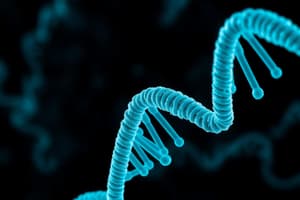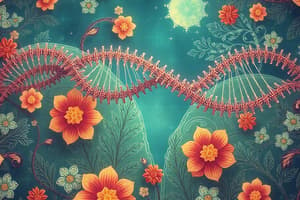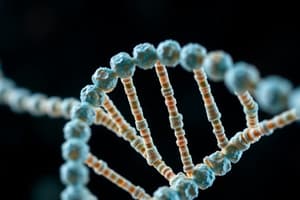Podcast
Questions and Answers
Which structure refers to proteins that consist of more than one polypeptide chain?
Which structure refers to proteins that consist of more than one polypeptide chain?
What is the primary function of chaperones in protein folding?
What is the primary function of chaperones in protein folding?
Which enzyme is responsible for synthesizing complementary DNA (cDNA) from mRNA?
Which enzyme is responsible for synthesizing complementary DNA (cDNA) from mRNA?
Which type of protein is characterized by a high axial ratio, indicating it is elongated in shape?
Which type of protein is characterized by a high axial ratio, indicating it is elongated in shape?
Signup and view all the answers
What aspect of a protein's structure is determined by the sequence of its amino acids?
What aspect of a protein's structure is determined by the sequence of its amino acids?
Signup and view all the answers
Which statement accurately describes the genetic code?
Which statement accurately describes the genetic code?
Signup and view all the answers
What is the primary biological role of plasma membrane proteins?
What is the primary biological role of plasma membrane proteins?
Signup and view all the answers
Which of the following statements is true regarding amino acids in proteins?
Which of the following statements is true regarding amino acids in proteins?
Signup and view all the answers
Which protein is specifically responsible for carrying oxygen in the blood?
Which protein is specifically responsible for carrying oxygen in the blood?
Signup and view all the answers
Which of the following proteins is considered a protective protein and provides chemical resistance?
Which of the following proteins is considered a protective protein and provides chemical resistance?
Signup and view all the answers
Study Notes
Introduction to Biotechnology
- Focuses on proteins as biotechnology products and cDNA
- Lecture 4, Spring Semester 2024-2025, at BADR UNIVERSITY IN CAIRO
- Dr. Mohamed Salah Basiouny
- Email: [email protected]
- Office No.: 234
The Central Dogma
- Shows the process of replication, transcription, and translation of DNA and RNA to produce proteins
- Replication: DNA → DNA
- Transcription: DNA → RNA
- Translation: RNA → Protein
Gene Regulation
- Covers the complexity of gene regulation mechanisms
- Includes replication, transcriptional regulation, reverse transcription, and translation regulation
- Mechanisms such as DNA methylation, histone modifications, SUMOylation, glycosylation, phosphorylation, ubiquitination, methylation, acylation, polyamination, and hydroxylation are mentioned
- Focuses on how these processes affect the production of functional proteins (mRNA processing and alternative splicing)
Genetic Code
- Genetic code is a triplet code
- Explains how three nucleotides form a codon which is "read" from a starting point in mRNA
- Shows a table of codons and the corresponding amino acids
- Properties of the genetic code: triplet code, non-ambiguous, universal, degenerate, no overlapping code, commaless, start and stop codons, polarity
Proteins as Biotechnology Products
- Proteins are polymers of α-amino acids
- Proteins are constructed from 20 common amino acids
- Nitrogen forms 16% of the weight of proteins
- Proteins' diverse roles, functions, structures, types, and biological importance are covered
- Includes their role as enzymes, receptors, antibodies, and hormones
- Discusses the different types of protein structures (primary, secondary, tertiary, and quaternary)
- Discusses Protein folding (spontaneous and facilitated by chaperones)
- Proteins are also classified into globular and fibrous proteins
Types of Proteins
- Globular and fibrous proteins are two major types of proteins categorized by shape
- Their axial ratio (length divided by width) is essential for their categorization
Complementary DNA (cDNA)
- cDNA is synthesized in the laboratory from messenger RNA (mRNA)
- cDNA is derived from genomic RNA, lacking promoters and introns
- The enzyme reverse transcriptase is used to create double-stranded cDNA from single-stranded mRNA
- cDNA can be used to study gene expression and function and in molecular and biotechnology research
Reverse Transcriptase
- Reverse transcription is the process of synthesizing double-stranded DNA from single-stranded RNA using reverse transcriptase
- Reverse transcriptase was discovered by Howard Temin and David Baltimore in 1970 independently
- Reverse transcriptase is common in retroviruses, like HIV, and play a role in cell regulation. Reverse transcriptase is an enzyme common in retroviruses.
Proteins in Biotechnology: Applications and Products
- Microbial fermentation and mammalian cell culture techniques for protein production
- Proteins are used in various industrial and medical applications
- Presents a table listing some protein-based pharmaceutical products, produced through recombinant protein technologies and their applications
- Emphasizes the importance of proteins in food processing, textiles, leather, and bioremediation processes
- Includes some enzymes and their applications (such as amylase, protease, and lipase)
Biotechnology Drugs and Medical Applications
- Detailing the use of microbial fermentation and mammalian cell cultures for producing therapeutic proteins
- Producing large batches in bioreactors, containing therapeutic protein genes, for producing protein products
Screening Molecules Associated with Disease
- Identification of marker proteins for rapid and accurate diagnosis of specific diseases
- Development of diagnostics based on protein markers
Applications of Proteins in Industry
- Applications in food processing, textiles, leather industries, and bioremediation, like heavy metal capture
Studying That Suits You
Use AI to generate personalized quizzes and flashcards to suit your learning preferences.
Related Documents
Description
This quiz covers key concepts from Lecture 4 of the Introduction to Biotechnology course at Badr University. Focus areas include the central dogma of molecular biology, gene regulation mechanisms, and the genetic code. Dive into the complexities of protein production and gene expression.




